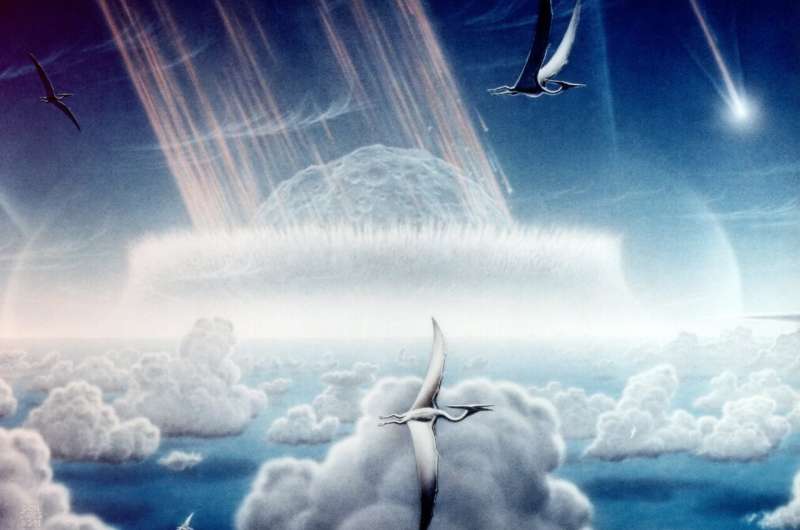May 25, 2018 report
Study of ancient fish suggests Chicxulub asteroid strike warmed planet for 100,000 years

A small team of researchers from the U.S. and Tunisia has found evidence that suggests a huge asteroid that struck the Earth approximately 66 million years ago caused the planet to warm up for approximately 100,000 years. In their paper published in the journal Science, the group describes their study of oxygen ratios in ancient fish bones and what it revealed.
Prior research has shown that approximately 66 million years ago, a massive asteroid struck the Earth at a point near what is now Chicxulub, Mexico. Other studies have suggested the sudden change in climate that resulted is what caused the dinosaurs to go extinct. The belief has been that the smoke and particles thrust into the atmosphere blocked out the sun causing the planet to cool for a long period of time. In this new effort, the researchers suggest the cooling period likely was shorter than thought and that it was followed by a lengthy hot spell. The researchers came to this conclusion by studying the bones and teeth of ancient fish.
The fish remains were sifted from sediment samples collected at a site in El Kef, Tunisia. During the time before and long after the asteroid strike, the area was covered by the Tethys Sea. The researchers looked at oxygen ratios in the fish remains as a means of determining the temperature of the water at the time that the fish died. Collecting samples from different layers allowed for building a temperature timeline that began before the asteroid strike and lasting hundreds of thousands of years thereafter. In looking at their timeline the group found that sea temperatures had risen approximately 5°C not long after the asteroid struck and had stayed at that temperature for approximately 100,000 years.
The researchers suggest the strike by the asteroid very likely released a lot of carbon dioxide into the atmosphere because the ground area where it struck was rich in carbonates. The strike very likely would have also ignited large long-burning forest fires which would have also released a lot of carbon into the air. The evidence suggests that the cooling after the impact was short-lived as massive amounts of carbon dioxide were released into the atmosphere setting off global warming.
The researchers note that a lot more work will need to be done to confirm their findings. Another site will have to be found with similar evidence, for example, to prove that the warming was not localized.
More information: K. G. MacLeod et al. Postimpact earliest Paleogene warming shown by fish debris oxygen isotopes (El Kef, Tunisia), Science (2018). DOI: 10.1126/science.aap8525
Abstract
Greenhouse warming is a predicted consequence of the Chicxulub impact, but supporting data are sparse. This shortcoming compromises understanding of the impact's effects, and it has persisted due to an absence of sections that both contain suitable material for traditional carbonate-based or organic-based paleothermometry and are complete and expanded enough to resolve changes on short time scales. We address the problem by analyzing the oxygen isotopic composition of fish debris, phosphatic microfossils that are relatively resistant to diagenetic alteration, from the Global Stratotype Section and Point for the Cretaceous/Paleogene boundary at El Kef, Tunisia. We report an ~1‰ decrease in δ18O values (~5°C warming) beginning at the boundary and spanning ~300 cm of section (~100,000 years). The pattern found matches expectations for impact-initiated greenhouse warming.
Journal information: Science
© 2018 Phys.org





















